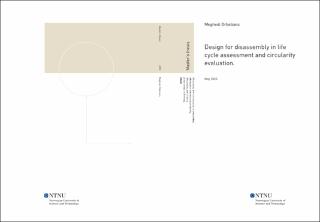| dc.description.abstract | While the world is facing material scarcity crises, the consumption of material resources is
increasing every day. With the building sector being one of the largest consumers of raw
materials, reuse of materials and therefore design to disassembly can be vital in building
design. Design for disassembly (DfD) can be time-consuming and expensive, although it can
result in the conservation of raw material resources. Therefore, finding methods to demonstrate
the benefits of DfD may lead to more application of this practice.
This thesis aims to find similarities and differences between LCA-based methods and circularity
indicators for implementing DfD in projects. This goal can help to identify which one of the LCAbased
methods and circularity evaluation methods can demonstrate the advantages of DfD. As
a first step, different LCA-based methods and circularity indicators were reviewed to find the
suitable method to incentivize the DfD. Then, three methods were chosen for testing, NS3720,
FutureBuilt Zero, and Urban Mining Index.
In this study, three options of a one-unit apartment of the “Treet” building in Norway with
different variations were introduced to test the DfD and no DfD variables. The inventory data
was collected from different literature searches and Environmental product declarations (EPD).
The global warming potential according to NS3720 and FutureBuilt Zero, and the circularity
potential based on the Urban Mining Index (UMI) of these three options were calculated for two life
cycles. The Reduzer software was used as a resource for the results of the first cycle. Based on
Dr. Rosen's dissertation and some adaptations to the Norwegian market by a previous master
thesis, UMI evaluation calculations of these options were performed.
The results suggest that the DfD method can positively impact the environment more than the
standard construction method. Moreover, it indicates that within the assigned system
boundaries, all three chosen methods can show the benefits of DfD in projects. However, the
choice between prefabricated modules and prefabricated elements remains unclear due to the
contrasting results of the methods. The promotion of DfD through LCA methods and circularity
indicators will serve as a central tool for developing components with multiple-use cycles, thus
it will assist in reducing the extraction of raw materials and the production of waste in the
construction sector | |
